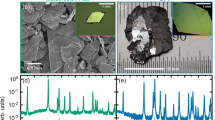Abstract
The formulae commonly cited for cordierite usually ignore the occupants of the structural channels that run parallel to the c-axis. Recently, however, it has been shown1 that two of the more common channel occupants, Na+ and molecular H2O, significantly modify cordierite's refractive indices (α, β, γ), optic angle (2Vx), unit cell dimensions, and the distortion index (Δ) defined by Miyashiro2. Indeed, for 11 natural cordierites, excluding indialites, Δ correlates almost entirely with channel Na+ and/or H2O and with Ra, the average radius of the ions occupying the octahedral sites, but not (as long believed) with Al/Si ordering. After heating at 800 °C for 6 h, Δ increased for the four crystals remeasured, and 2Vx increased for the nine optically (−) crystals but decreased to below 90° for the two optically (+) crystals. Selkregg and Bloss1 attributed these effects to loss of channel H2O and/or Na+ but did not explain why the two (+) crystals became (−) after heating. We report here that loss of molecular CO2, a frequently reported channel occupant3–5, was the reason. We observe that for Mg-cordierite, 2Vx is ∼87° if its channels are vacant, decreases to 45° or less as channel H2O increases and increases to 114° with increasing channel CO2 (but no H2O). Channel CO2 is apparently the long-sought-for cause of optically (+) cordierites.
This is a preview of subscription content, access via your institution
Access options
Subscribe to this journal
Receive 51 print issues and online access
$199.00 per year
only $3.90 per issue
Buy this article
- Purchase on Springer Link
- Instant access to full article PDF
Prices may be subject to local taxes which are calculated during checkout
Similar content being viewed by others
References
Selkregg, K. & Bloss, F. D. Am. Miner. (in the press).
Miyashiro, A. Am. J. Sci. 255, 43–62 (1957).
Farrell, E. F. & Newnham, R. E. Am. Miner. 52, 380–388 (1967).
Farmer, V. C. The Infrared Spectra of Minerals (Mineralogical Society, London, 1974).
Goldman Don, S., Rossman, G. R. & Dollase, W. A. Am. Miner, 62, 1144–1157 (1977).
Kuznetsova, F. V., Bondareva, G. V. & Russakova, V. A. Mineralogy of Cisbaikalia, (ed. Shmakin, B. M.) I47–I57 (11th Meet. int. Miner. Ass., 1978).
Wallace, J. H. & Wenk, H. R. Am. Miner, 65, 96–111 (1980).
Bloss, F. D. The Spindle Stage: Principles and Practice (Cambridge University Press, in the press).
Medenbach, O., Maresch, W. V., Mirwald, P. W. & Schreyer, W. Fortschr. Miner. 1, 57, 99–101 (1979).
Lepezin, G. G., Kuznetsova, I. K., Lavrent'ev, Yu. G. & Chmel'nicova, O. S. Contr. Miner. Petrol, 58, 319–329 (1976).
Author information
Authors and Affiliations
Rights and permissions
About this article
Cite this article
Armbruster, T., Bloss, F. Channel CO2 in cordierites. Nature 286, 140–141 (1980). https://doi.org/10.1038/286140a0
Received:
Accepted:
Issue Date:
DOI: https://doi.org/10.1038/286140a0
This article is cited by
-
Primary cordierite with > 2.5 wt% CO2 from the UHT Bakhuis Granulite Belt, Surinam: CO2 fluid phase saturation during ultrahigh-temperature metamorphism
Contributions to Mineralogy and Petrology (2023)
-
New finding of sillmanite in sapphirine-bearing granulites from Pedapalli, NE part of the Eastern Dharwar Craton, India
Journal of the Geological Society of India (2014)
-
Static elasticity of cordierite II: effect of molecular CO2 channel constituents on the compressibility
Physics and Chemistry of Minerals (2014)
-
Quantitative analysis of H2O and CO2 in cordierite using polarized FTIR spectroscopy
Contributions to Mineralogy and Petrology (2012)
-
Application of micro-FTIR imaging in the Earth sciences
Analytical and Bioanalytical Chemistry (2010)
Comments
By submitting a comment you agree to abide by our Terms and Community Guidelines. If you find something abusive or that does not comply with our terms or guidelines please flag it as inappropriate.



